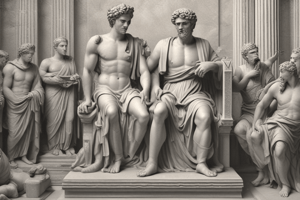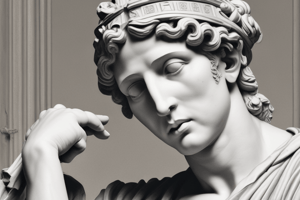Podcast
Questions and Answers
Which architectural feature is most characteristic of Gothic environmental design?
Which architectural feature is most characteristic of Gothic environmental design?
- Round Arches
- Flat Arches
- Doric Columns
- Pointed Arches (correct)
What material innovation was most significant in Roman environmental design?
What material innovation was most significant in Roman environmental design?
- Vellum
- Marble
- Limestone
- Concrete (correct)
Which design category is most closely associated with Frescoe paintings during the Greek period?
Which design category is most closely associated with Frescoe paintings during the Greek period?
- Visual Communication (correct)
- Product Design
- Surface Design
- Environmental Design
What best describes a key belief that influenced Greek design?
What best describes a key belief that influenced Greek design?
Which material was commonly used for Gothic manuscripts to convey stories?
Which material was commonly used for Gothic manuscripts to convey stories?
Which architectural element is defined as a half-dome cavity set into a wall, often used to display statues or decorative objects?
Which architectural element is defined as a half-dome cavity set into a wall, often used to display statues or decorative objects?
What is the primary function of squinch arches in the construction of a dome?
What is the primary function of squinch arches in the construction of a dome?
Which of the following materials was commonly used in Baroque architecture?
Which of the following materials was commonly used in Baroque architecture?
Which painting technique is designed to 'deceive the eye', often used on ceilings to create illusions of depth and material reality?
Which painting technique is designed to 'deceive the eye', often used on ceilings to create illusions of depth and material reality?
What is the architectural term for the upright section of a building upon which a dome is raised?
What is the architectural term for the upright section of a building upon which a dome is raised?
Which of the following best describes the general themes emphasized during the Baroque period?
Which of the following best describes the general themes emphasized during the Baroque period?
In the context of architectural design, what is an 'aedicula'?
In the context of architectural design, what is an 'aedicula'?
Which element is considered the 'face' or front exterior of a building?
Which element is considered the 'face' or front exterior of a building?
Flashcards
Greek Art
Greek Art
Art from 900 to 30 BCE, emphasizing harmony, proportion, and themes like mythology and human experience.
Roman Arch
Roman Arch
Architectural innovation using a round arch, reflecting evolution in Greek style and themes of wealth and power.
Gothic Architecture
Gothic Architecture
Medieval style featuring pointed arches, ribbed vaults, and flying buttresses, reflecting Christianity and historical themes.
Renaissance Shift
Renaissance Shift
Signup and view all the flashcards
Surface Design in Gothic
Surface Design in Gothic
Signup and view all the flashcards
Beliefs in Humanism
Beliefs in Humanism
Signup and view all the flashcards
Dome
Dome
Signup and view all the flashcards
Pilaster
Pilaster
Signup and view all the flashcards
Aediculae
Aediculae
Signup and view all the flashcards
Baroque Style
Baroque Style
Signup and view all the flashcards
Frescoes
Frescoes
Signup and view all the flashcards
Trompe l’oeil
Trompe l’oeil
Signup and view all the flashcards
Vaulted Cupolas
Vaulted Cupolas
Signup and view all the flashcards
Study Notes
Greek Period (900-30 BCE)
- Style: Harmony, tranquility, proportion
- Themes: Lifestyle, mythology, literature, the human form
- Beliefs: Balance of soul and body, Greek gods, law
- Visual Communication: Frescoes (water-based paint on wet plaster)
- Surface Design: Mosaics (pigmented tiles and stone for flooring)
- Product Design: Pottery (ceramics for practical use and events)
- Environmental Design: Architecture (Doric, Ionic, and Corinthian columns; flat arch; temples, stadiums, monuments; limestone and marble)
Roman Period (509 BCE-330 CE)
- Style: Evolving Greek style, using different materials and themes
- Themes: Wealth, power, mathematics
- Beliefs: Greek-based gods, empowered government
- Visual Communication: Heraldry, emblems, flags—to convey status
- Surface Design: Tapestries, mosaics, frescoes (decorative elements)
- Product Design: Practical objects —clothing, pottery, jewelry, furniture
- Environmental Design: Architecture (round arch; temples, stadiums, monuments; concrete)
Gothic Period (Mid 12th-Late 16th Century)
- Style: Medieval art, evolving from Romanesque, valuing status, influenced by Middle East and Europe
- Themes: Historical events, chivalric and hunting scenes, religious scenes
- Beliefs: Christianity (Old and New Testaments)
- Surface Design: Manuscripts (Vellum and animal skins, especially calfskin parchment, for conveying stories)
- Environmental Design: Architecture (pointed arches, ribbed vaults, flying buttresses, stained/rose glass windows, ornaments; cathedrals, government buildings; stone, concrete, glass)
Renaissance Period (14th-17th Century)
- Style: Shift from abstract medieval to historical/religious forms in the 15th century
- Themes: Christianity, realism, humanism
- Beliefs: Humanism, science, education, art, literature, Christianity
- Environmental Design: Architecture (domes, drums, niches, aediculae, columns, pilasters, pendentives, squinch arches, facades, cornices; monuments, shrines, temples, cathedrals; stone, marble, bronze, gold)
Baroque Period (17th-Early 18th Century)
- Style: Emphasizes dramatic movement, clear details
- Themes: Christianity, grand illustrations, intense lighting, Renaissance rebellion
- Beliefs: Sensuous and spiritual
- Surface Design: Tapestries, clothing, mirrors—elaborately decorated items crafted from silk, gold, silver, glass
- Environmental Design: Architecture (vaulted cupolas, twirling colonnades, frescoes, trompe l’oeil paintings, niches, domes, pilasters, drums; elaborate interiors; cathedrals, churches, fountains, plazas, universities, government buildings, monuments; diverse materials)
Studying That Suits You
Use AI to generate personalized quizzes and flashcards to suit your learning preferences.




